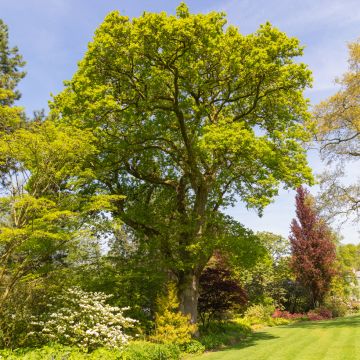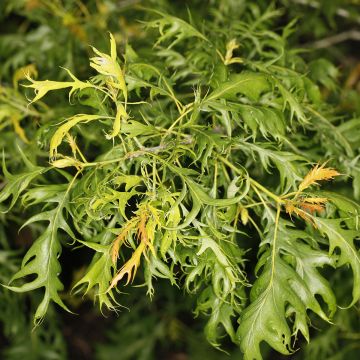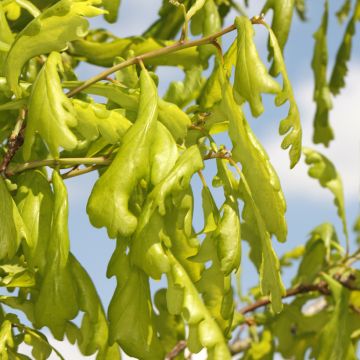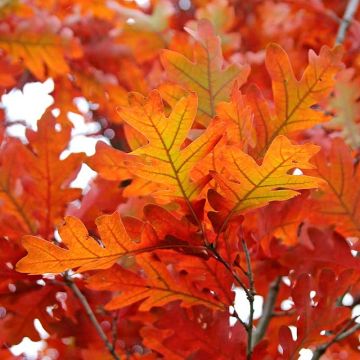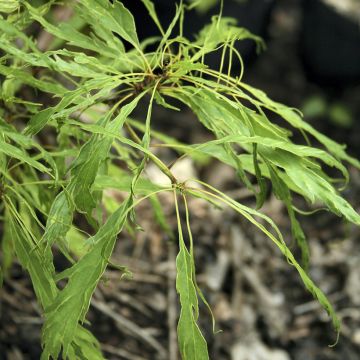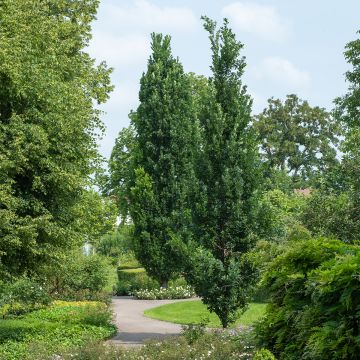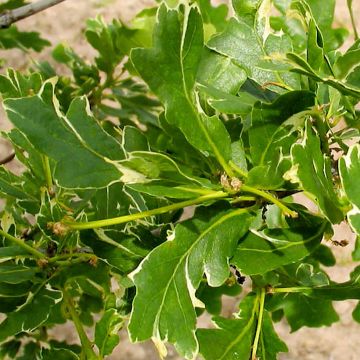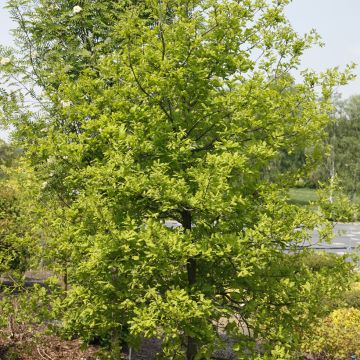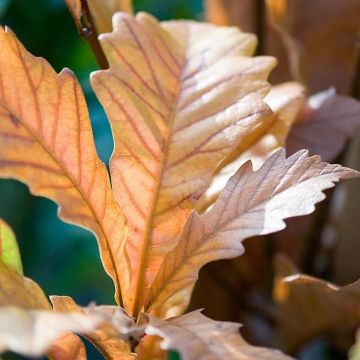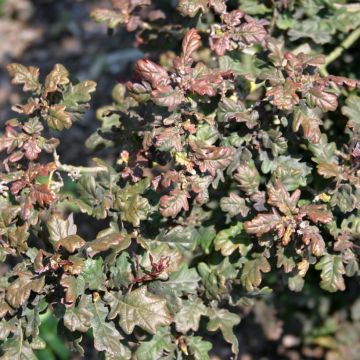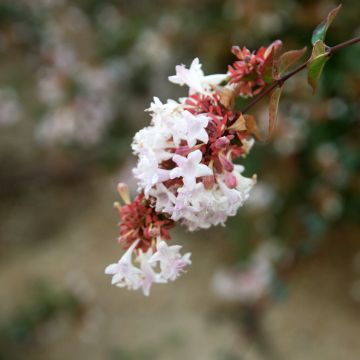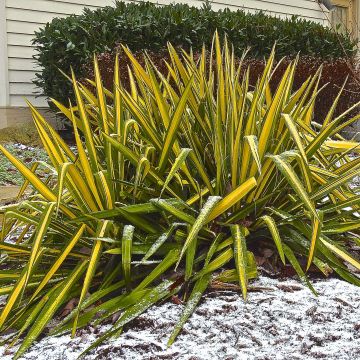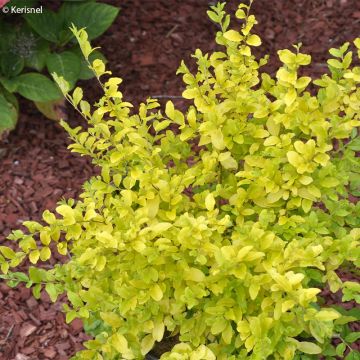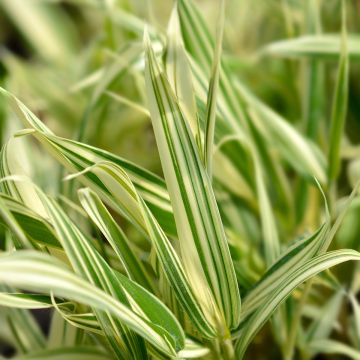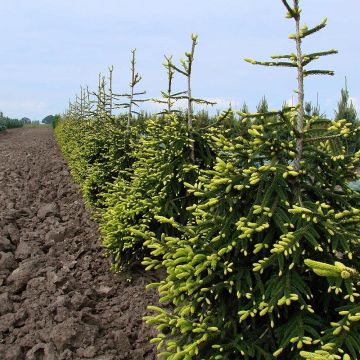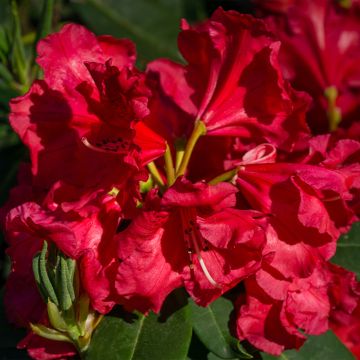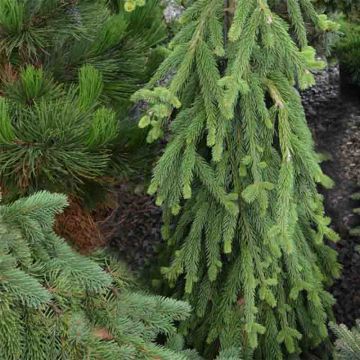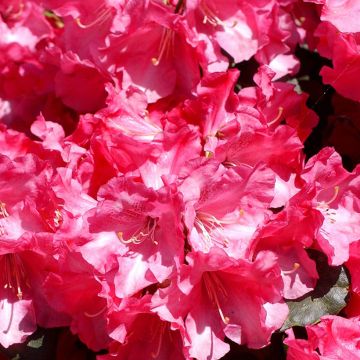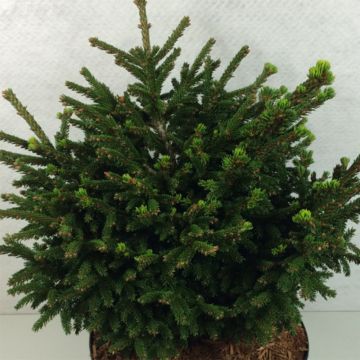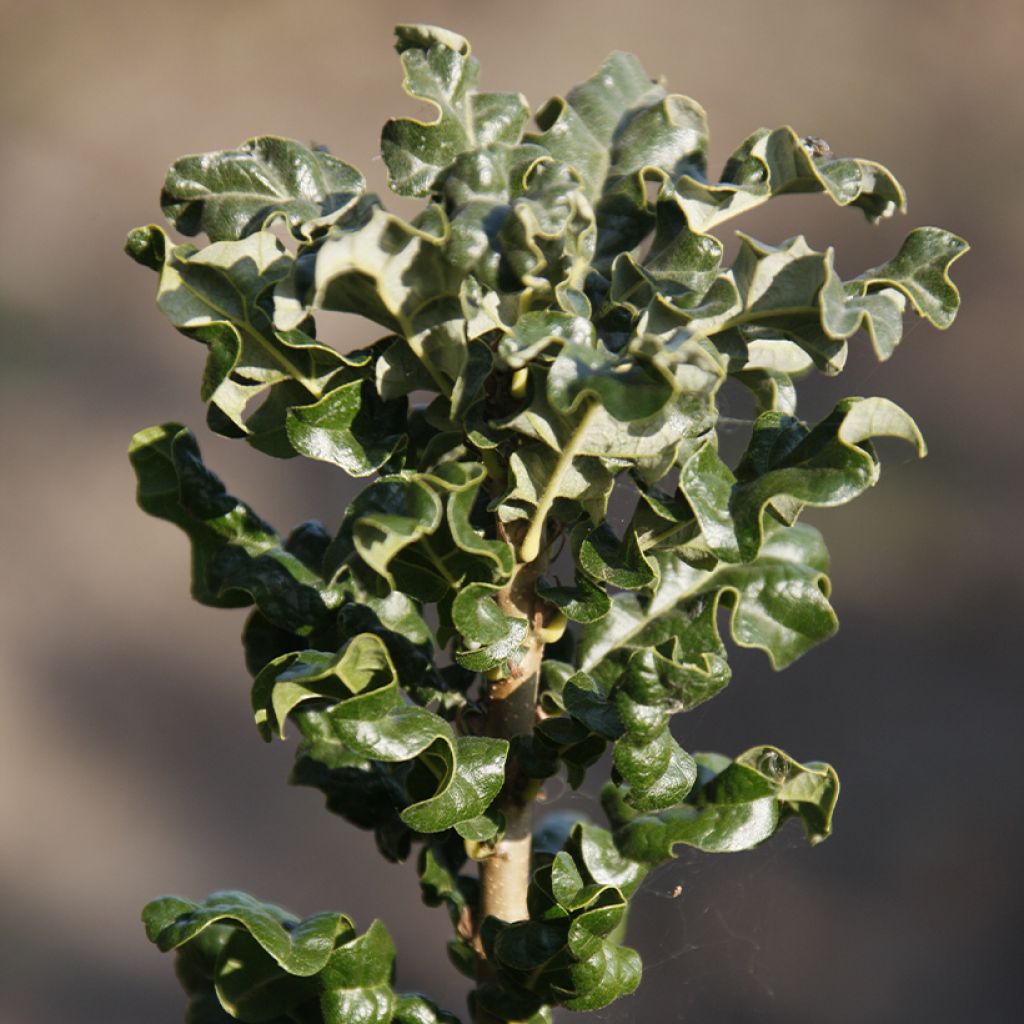

Quercus cerris Curly Head - Oak
Quercus cerris Curly Head - Oak
Quercus cerris Curly Head
Turkey Oak
This item cannot be shipped to the selected country
Delivery charge from €5.90
More information
Schedule delivery date,
and select date in basket
This plant carries a 24 months recovery warranty
More information
We guarantee the quality of our plants for a full growing cycle, and will replace at our expense any plant that fails to recover under normal climatic and planting conditions.
From €5.90 for pickup delivery and €6.90 for home delivery
Express home delivery from €8.90.

Does this plant fit my garden?
Set up your Plantfit profile →
Description
Quercus cerris Curly Head is a rare and distinctly atypical variety of the Curly Oak, which differs from the species in terms of foliage, silhouette, and size. It has a much slower growth rate than the botanical species, remaining compact with a narrow habit, not exceeding 3 to 4 metres in height after many years. Its foliage, in particular, is extremely unique, with its crinkled appearance due to the astonishing curling of the leaves. With its beautiful dark green glossy look, this vegetation never fails to amaze. In autumn, it turns yellow before drying out and remains on the plant practically until the new leaves appear.
The Curly Oak belongs to the Fagaceae family, like Beech and Chestnut. It is native to southeastern Europe and is widespread from the Balkan Peninsula to the western shore of the Black Sea and central Europe. It is a species of warm temperate climate that appreciates limestone soils but is sensitive to prolonged droughts. The botanical species, with its rapid growth, reaches an average height of 20 metres and a spread of 10-12 metres, but its habit varies greatly, being more or less spreading and irregular. This oak develops a crown that is initially conical and becomes more rounded over time.
Curly Head is probably one of its most surprising varieties. This selection was made by the Dutch nurseryman M.M. Bömer, from Zundert (Van Gogh's hometown, in the south of the Netherlands, near the Belgian border). The original plant, discovered around 1989, measured only 1.50 metres in 2005, which illustrates its slow growth... It varies depending on the climate, but after 10 years of growth, the plant will reach a height of 2 metres and a width of 80 cm to 1 metre. Its final height at maturity, after a few decades, is estimated to be between 3 and 4 metres. With its narrow habit, few branches, and several well-erected vertical axes, around which groups of leaves cluster, Curly Head resembles a Mahonia or a Boxwood more than an Oak!
Its foliage is also atypical. The leaves are slightly smaller than those of the species, measuring 8 to 10 cm in length and 3 to 4 cm in width. The leaf has rounded, more or less deep lobes, which a keen eye will recognise as oak leaves upon close observation. However, due to the highly crinkled nature of the leaves, their strongly wavy surface will confuse many. They are dark green, shiny and highly decorative. The leaves are clustered on the branches, further enhancing the uniqueness of the plant. The branches are velvety, grey-green or brown-green, while the bark is almost black and rough.
In April-May, this small Oak produces golden yellow, 5 to 6 cm long catkins, which will give oval, 2.5 to 3 cm acorns grouped in clusters of 1 to 4. The cupules are adorned with long, slender, and curved scales (hence the name Curly Oak).
When autumn arrives, the foliage turns yellow and brown, and the dry leaves, which are almost marcescent, persist on the plant until the emergence of new leaves the following year.
This oak is hardy to approximately -24°C and grows well in limestone soil, as well as in neutral to slightly acidic soils. Once well-rooted, it tolerates drought relatively well but appreciates occasional watering. However, it does not tolerate stagnant water. It thrives in a sunny exposure but also tolerates light shade.
Quercus cerris Curly Head is one of those distinctive plants that some adore and others avoid. It is easy to cultivate and will appeal to enthusiasts and collectors with its strange appearance. It will find its perfect place in a "bizarretum," a part of the garden or a bed dedicated to plants with atypical silhouettes. In the background, you can plant the astonishing Cryptomeria japonica 'Araucarioides', a conifer with long thread-like branches composed of very small overlapping needles. Another possible companion is Cercis canadensis Alley Cat, a Canadian Redbud with large green leaves splashed with white. Its pink flowering, which appears directly on the bare wood and early in spring, is always surprising. Also, consider the unusual fruiting of Decaisnea fargesii, a shrub whose clusters of cream-yellow star-shaped flowers are out of the ordinary...
Report an error about the product description
Plant habit
Flowering
Foliage
Botanical data
Quercus
cerris
Curly Head
Fagaceae
Turkey Oak
Cultivar or hybrid
Other Oak
Planting and care
Quercus cerris Curly Head should be planted in autumn or spring, outside the freezing period. It prefers deep, fertile soils that are not too dry in summer, slightly acidic, neutral or limestone. It dislikes shallow rocky soils, excessively acidic or waterlogged. It prefers sunny and open exposures, but can also grow under light shade. Prepare a planting hole 60 cm on each side and deep to loosen the soil well. Soak the root ball in a bucket of water for fifteen minutes before planting, then water abundantly. Protect it from excessively dry summers in the years following planting and water regularly. It is a tree that, once established, requires very little maintenance. It is particularly resistant to diseases and parasites.
Planting period
Intended location
Care
-
, onOrder confirmed
Reply from on Promesse de fleurs
Evergreen shrubs
Haven't found what you were looking for?
Hardiness is the lowest winter temperature a plant can endure without suffering serious damage or even dying. However, hardiness is affected by location (a sheltered area, such as a patio), protection (winter cover) and soil type (hardiness is improved by well-drained soil).

Photo Sharing Terms & Conditions
In order to encourage gardeners to interact and share their experiences, Promesse de fleurs offers various media enabling content to be uploaded onto its Site - in particular via the ‘Photo sharing’ module.
The User agrees to refrain from:
- Posting any content that is illegal, prejudicial, insulting, racist, inciteful to hatred, revisionist, contrary to public decency, that infringes on privacy or on the privacy rights of third parties, in particular the publicity rights of persons and goods, intellectual property rights, or the right to privacy.
- Submitting content on behalf of a third party;
- Impersonate the identity of a third party and/or publish any personal information about a third party;
In general, the User undertakes to refrain from any unethical behaviour.
All Content (in particular text, comments, files, images, photos, videos, creative works, etc.), which may be subject to property or intellectual property rights, image or other private rights, shall remain the property of the User, subject to the limited rights granted by the terms of the licence granted by Promesse de fleurs as stated below. Users are at liberty to publish or not to publish such Content on the Site, notably via the ‘Photo Sharing’ facility, and accept that this Content shall be made public and freely accessible, notably on the Internet.
Users further acknowledge, undertake to have ,and guarantee that they hold all necessary rights and permissions to publish such material on the Site, in particular with regard to the legislation in force pertaining to any privacy, property, intellectual property, image, or contractual rights, or rights of any other nature. By publishing such Content on the Site, Users acknowledge accepting full liability as publishers of the Content within the meaning of the law, and grant Promesse de fleurs, free of charge, an inclusive, worldwide licence for the said Content for the entire duration of its publication, including all reproduction, representation, up/downloading, displaying, performing, transmission, and storage rights.
Users also grant permission for their name to be linked to the Content and accept that this link may not always be made available.
By engaging in posting material, Users consent to their Content becoming automatically accessible on the Internet, in particular on other sites and/or blogs and/or web pages of the Promesse de fleurs site, including in particular social pages and the Promesse de fleurs catalogue.
Users may secure the removal of entrusted content free of charge by issuing a simple request via our contact form.
The flowering period indicated on our website applies to countries and regions located in USDA zone 8 (France, the United Kingdom, Ireland, the Netherlands, etc.)
It will vary according to where you live:
- In zones 9 to 10 (Italy, Spain, Greece, etc.), flowering will occur about 2 to 4 weeks earlier.
- In zones 6 to 7 (Germany, Poland, Slovenia, and lower mountainous regions), flowering will be delayed by 2 to 3 weeks.
- In zone 5 (Central Europe, Scandinavia), blooming will be delayed by 3 to 5 weeks.
In temperate climates, pruning of spring-flowering shrubs (forsythia, spireas, etc.) should be done just after flowering.
Pruning of summer-flowering shrubs (Indian Lilac, Perovskia, etc.) can be done in winter or spring.
In cold regions as well as with frost-sensitive plants, avoid pruning too early when severe frosts may still occur.
The planting period indicated on our website applies to countries and regions located in USDA zone 8 (France, United Kingdom, Ireland, Netherlands).
It will vary according to where you live:
- In Mediterranean zones (Marseille, Madrid, Milan, etc.), autumn and winter are the best planting periods.
- In continental zones (Strasbourg, Munich, Vienna, etc.), delay planting by 2 to 3 weeks in spring and bring it forward by 2 to 4 weeks in autumn.
- In mountainous regions (the Alps, Pyrenees, Carpathians, etc.), it is best to plant in late spring (May-June) or late summer (August-September).
The harvesting period indicated on our website applies to countries and regions in USDA zone 8 (France, England, Ireland, the Netherlands).
In colder areas (Scandinavia, Poland, Austria...) fruit and vegetable harvests are likely to be delayed by 3-4 weeks.
In warmer areas (Italy, Spain, Greece, etc.), harvesting will probably take place earlier, depending on weather conditions.
The sowing periods indicated on our website apply to countries and regions within USDA Zone 8 (France, UK, Ireland, Netherlands).
In colder areas (Scandinavia, Poland, Austria...), delay any outdoor sowing by 3-4 weeks, or sow under glass.
In warmer climes (Italy, Spain, Greece, etc.), bring outdoor sowing forward by a few weeks.

































